Where Does Green Marble Come From? — Global Sources, Geology, Buying & Industry Trends
Where does green marble come from?
Table of Contents
Toggle- Where does green marble come from?
- 1 — Quick answer: Where is green marble found?
- 2 — How green marble forms (the geology explained simply)
- 3 — Key green-marble localities — details & context
- 4 — Trade name vs geological name: why origin matters when you buy
- 5 — Where to buy: manufacturers, factories, wholesalers — a sourcing checklist
- 6 — Industry trends & regulations that shape sourcing decisions
- 7 — Shipping, lead time & quality checks (what to request before purchase)
- 8 — Design & application notes tied to origin
- 9 — FAQ — Top 5 Google-trending questions (short answers)
- Semantic Closure: How / Why / Options / Considerations
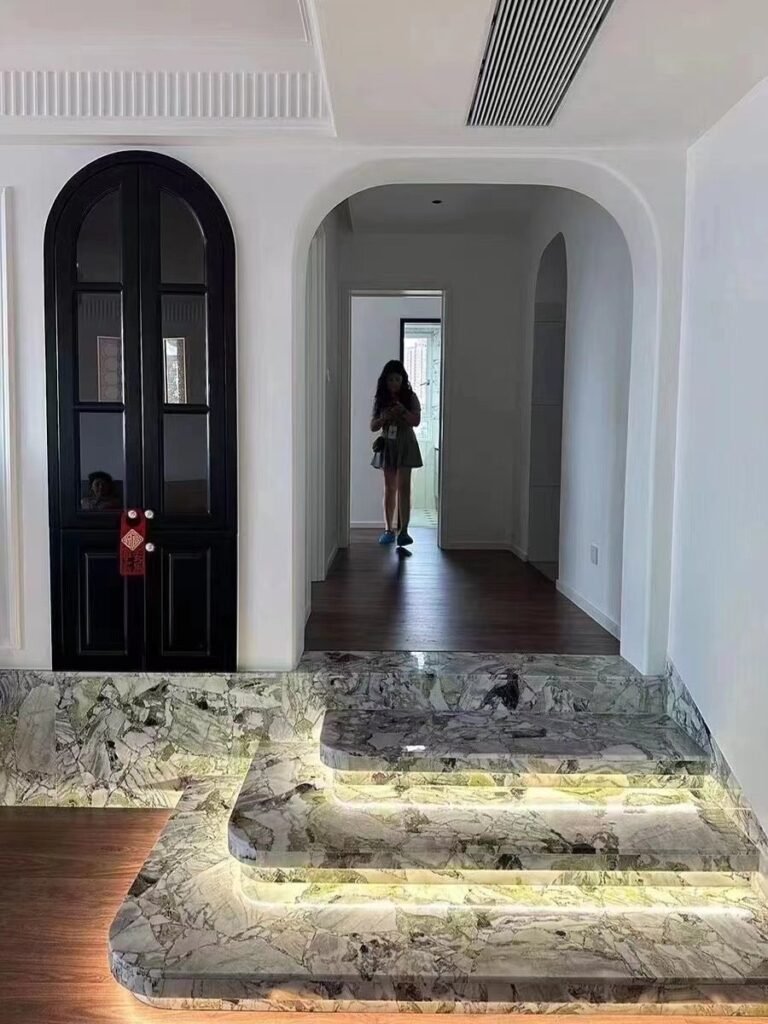
1 — Quick answer: Where is green marble found?
Green marbles are globally distributed. Well-known, historically and commercially important localities include:
Connemara (County Galway), Ireland — the iconic “Connemara marble” or Irish green.
Kolmården (Oxåker), Sweden — often marketed as “Swedish green” or Kolmården marble; used in prominent buildings for centuries.
Italy (Aosta Valley, e.g., Verde Alpi) — classic European green marbles used in high-end interiors.
India (Rajasthan — trade names like “Verde Guatemala” / Verde India) — large commercial quarries supplying slabs and tiles worldwide.
Turkey, Greece, China, Guatemala, and other countries — additional sources or trade names appear worldwide; some trade names refer to visual similarity rather than strict geographic origin.
(Short takeaway: “green marble” is a market term covering a family of stones with green hues — always check the exact quarry / geological name when provenance matters.)
2 — How green marble forms (the geology explained simply)
Marble is metamorphosed limestone or dolomite — heat and pressure recrystallize carbonate minerals (calcite/dolomite). The green colour is not a single pigment but the visible expression of secondary/ accessory minerals that occur during metamorphism or later hydrothermal activity:
Serpentine (or serpentine-group minerals) and chlorite commonly produce the green shades found in many classic green marbles (Connemara and Kolmården have significant serpentine content).
Epidote, diopside, forsterite, and trace amounts of iron or chromium can shift tones from soft sage to deep forest green.
Some “green” decorative stones sold in trade are serpentinites or serpentinite-breccias (e.g., classic Mediterranean “verde antico” types), which are geologically different from true calcitic marbles — this influences translucency, hardness, and reaction to acids. 維基百科
Why this matters: the mineralogy determines hardness, polishability, translucency, etch resistance, and suitability for different applications (e.g., floor vs. backlit panel).
3 — Key green-marble localities — details & context
Connemara, Ireland — “Irish green”
Connemara marble is a celebrated material from western Ireland (County Galway). It is a calcitic/dolomitic marble with abundant serpentine and other silicate minerals; the result is mottled greens with cream veins and occasional darker matrix. Geologists and gemologists have long studied its unique mineral distribution. Connemara marble’s identity is tied to place — ask suppliers for quarry origin when the name is used commercially. 維基百科+1
Kolmården / Swedish Green
Kolmården (Oxåker quarry area) in Sweden produces a fine-grained Swedish green marble that has been quarried since the 17th century. It’s renowned for durability and even coloration and has been used in major public buildings (Stockholm City Hall, etc.). If your spec calls for “Swedish green” or Kolmården, request Oxåker-origin documentation.
Italy — Verde Alpi and other Alpine greens
Italy’s green marbles (often sold as Verde Alpi, Verde Saint Denis, etc.) come from the Alps region (Aosta Valley and nearby) and are prized for deep, elegant greens and exceptional polish. These are frequently used in bespoke luxury work.
India (Rajasthan) — large commercial production
India (notably Rajasthan — Udaipur/Bidasar region) supplies significant volumes of green marble to global markets, sometimes marketed under trade names like “Verde Guatemala” or Verde India. These stones are affordable to mid-tier markets and are widely available in slabs and tiles. When sourcing from India, ask for the specific mine/region (e.g., Rishabhdeo/Kesariyaji quarries are cited in trade guides).
Turkey, Greece, China, Guatemala — other sources
Turkey and Greece have both classical and modern green decorative stones; China and other producing nations also export green marbles or lookalike stones. Guatemala is sometimes referenced in trade names, but the name “Verde Guatemala” is also used for stones quarried in other countries — always verify. A market survey lists dozens of countries producing green marbles and serpentinites.
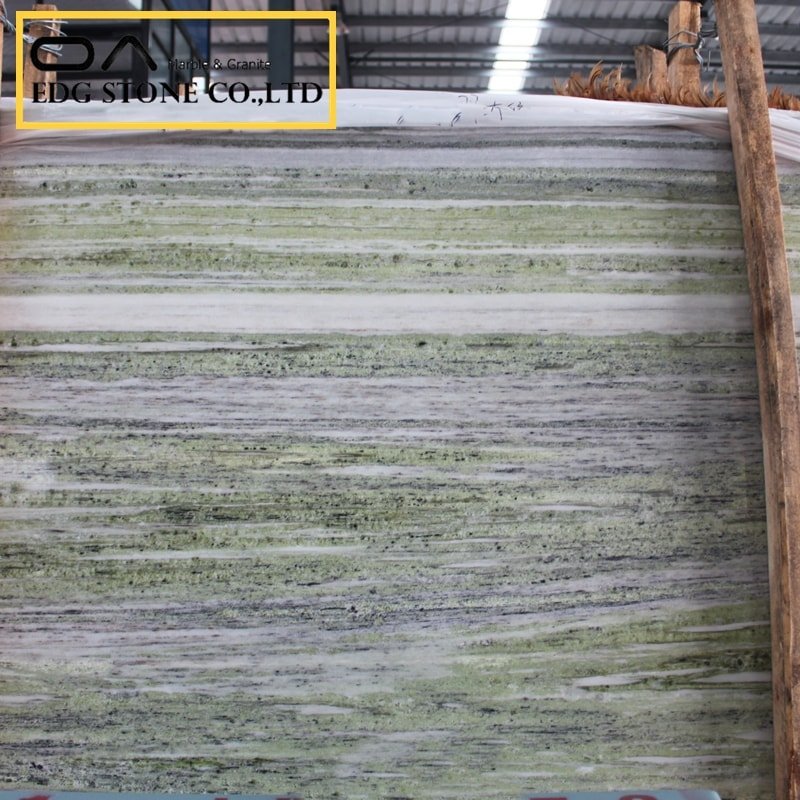
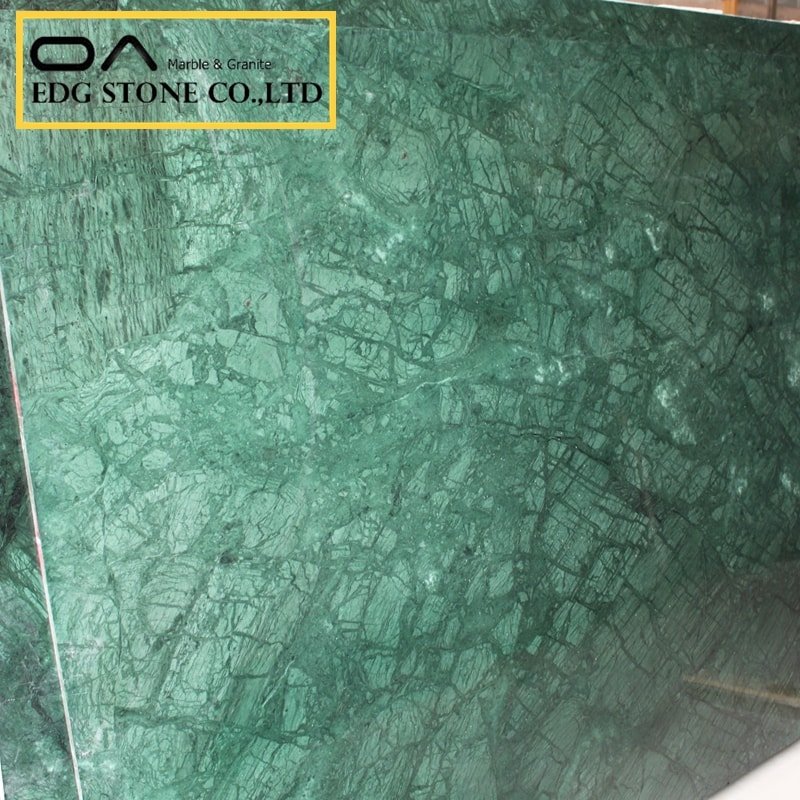
4 — Trade name vs geological name: why origin matters when you buy
A key pitfall in buying natural stone is inconsistent naming. “Verde Guatemala,” “Verde Alpi,” “Irish green” can mean different things depending on the supplier:
Trade name ambiguity: suppliers sometimes label a visually similar stone with a traditional or marketing name that implies origin when the material is different or from another quarry.
Geological name clarity: the clearest specification includes quarry name, geological name (e.g., “calcitic marble with serpentine from Lissoughter, Connemara”), slab photos, and lab/petrographic results when necessary.
Why it matters: origin affects color consistency, availability of matched slabs, pricing, and long-term maintenance characteristics. Ask for slab book-matching photos, quarry certificates, and test results if translucency, hardness, or composition matters for your project.
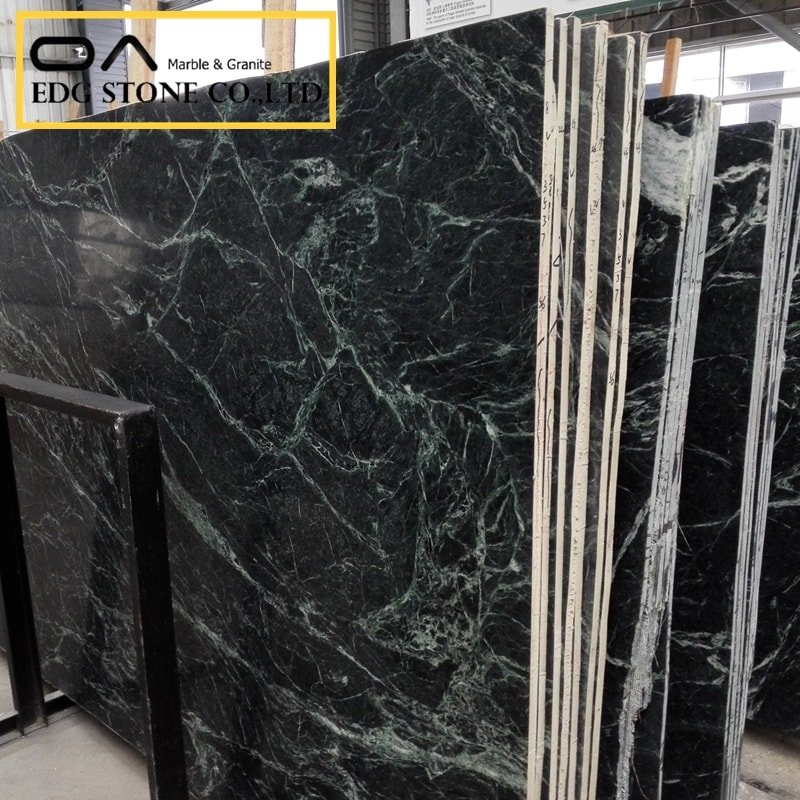
5 — Where to buy: manufacturers, factories, wholesalers — a sourcing checklist
If you need to source green marble (manufacturer/factory/wholesale), here’s a practical checklist to reduce risk:
Request origin & quarry name — insist on exactly where the block was quarried. (Quarry provenance is a major quality signal.)
Ask for full slab photos and video — not just thumbnails; videos of lighting and edge detail help with color judgement.
Get technical documentation: MSDS, Petrographic report, and, where available, EPD or HPD.
Sampling: demand at least two slab samples (20–30 mm) and a backlit sample for onyx-like/translucent stones.
Quality & matching: request book-matched pairs or identify lot numbers for large projects.
Safety & compliance proof: verify the fabricator’s dust-control procedures and silica monitoring records (especially important when cutting and finishing).
Shipping & logistics: confirm lead times (often 4–12 weeks), insurance, customs paperwork and slab tagging to avoid mismatches at arrival.
Large B2B buyers often work with quarry agents or established stone houses to secure consistent lots and negotiate no-MOQ options for designers.
6 — Industry trends & regulations that shape sourcing decisions
Sourcing green marble today is influenced by worker-safety rules, sustainability disclosure requirements, and regional bans targeting high-silica engineered stone. Key trends:
Silica/worker safety (fabrication risk)
National regulators (OSHA in the U.S., state DOSH offices, and international bodies) enforce limits and require engineering controls. OSHA’s construction silica standard sets an action level of 25 μg/m³ (8-hour TWA) and requires employers to use wet methods, local exhaust, respiratory protection, and medical surveillance when exposures exceed limits. The general industry PEL for general industry is 50 μg/m³ (8-hour TWA). These standards are actively enforced in targeted inspections. 職業安全健康管理局+2職業安全健康管理局+2
Industry guidance & sampling
Industry groups (Natural Stone Institute, ISFA) published guidance and exposure assessment tools (2024 onward) to help fabricators monitor respirable dust and meet regulators, important because many buyers now ask fabricators for documented dust-control programs.
EPDs, HPDs, and sustainability disclosure
Environmental Product Declarations (EPDs) and Health Product Declarations (HPDs) for natural stone are increasingly requested by architects and procurement teams; they help compare life-cycle environmental impacts and often favor natural stone as a lower-carbon choice when transparently reported. The Natural Stone Institute has published industry-wide EPDs and encourages product-specific reporting.
Policy actions (engineered stone bans and scrutiny)
Several jurisdictions have moved to restrict or ban uncontrolled use/manufacture of engineered stone due to silicosis cases in the engineered-stone fabrication sector — e.g., Australia introduced restrictions and import controls in 2024–2025. While natural green marble is not engineered quartz, the regulatory attention increases market demand for documented safe practices across all stone fabrication. 新聞網+1
Implication for buyers: prefer suppliers/fabricators with dust-control documentation, willingness to provide EPD/HPD data, and transparent provenance to reduce regulatory and reputational risk.
7 — Shipping, lead time & quality checks (what to request before purchase)
Lead times: Typical quarry-to-door timelines vary by origin — local European stones (Italy, Sweden) may be faster; Asian shipments (India, China) often require 6–12 weeks depending on cut and finishing. Confirm lead times before specifying material in a project schedule.
Quality checks to require: slab photos, edge thickness confirmation, pallet packing photos, customs/invoice harmonized codes, and insurance. For big projects, include pre-shipment inspection by a third party.
Samples & lighting tests: always test final slabs in situ under actual project lighting — many green marbles change appearance between natural and artificial light.
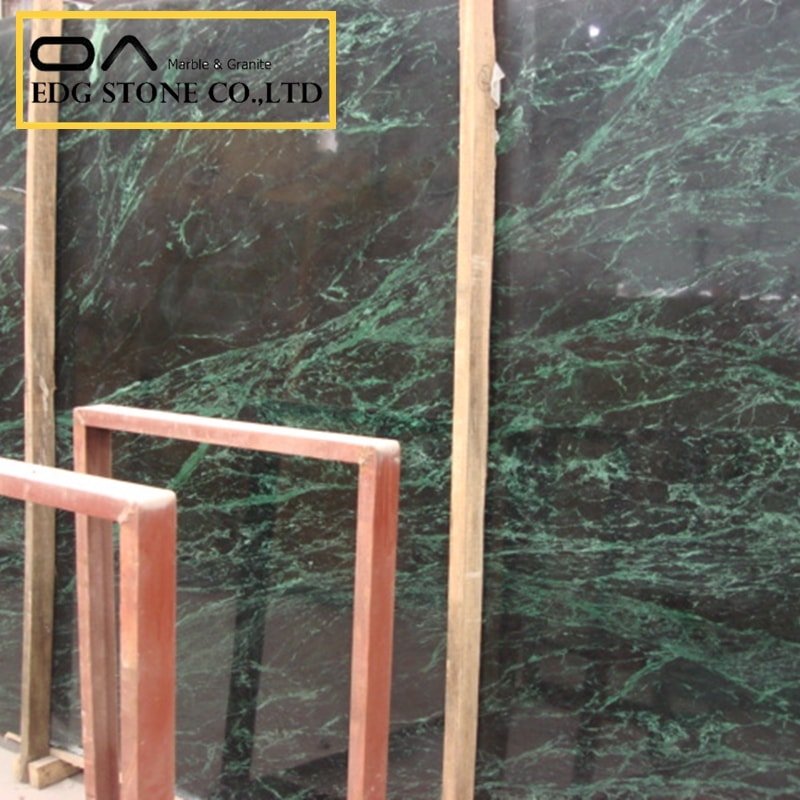
8 — Design & application notes tied to origin
Different origins produce differently-behaved stones:
Connemara (Ireland): very popular for decorative inlays, jewelry, and feature walls; the serpentine-rich composition is visually distinctive but may need careful sealing on horizontal surfaces. 維基百科
Swedish Kolmården: prized for flooring and stairs due to historical use and relative durability — used in high-traffic civic buildings.
Italian Verde Alpi: often used for luxurious cladding and statement surfaces because of deep polish and refined veining.
Indian / commercial green marbles: cost-effective and widely available for floors, wall tiles, and mid-market counters — check for consistency across slabs.
Match finish to use: polished for dramatic interiors, honed or leathered finishes where slip-resistance or concealment of wear is needed.
9 — FAQ — Top 5 Google-trending questions (short answers)
Q1: Where is green marble found?
A1: Across many countries — Ireland (Connemara), Sweden (Kolmården), Italy (Aosta/Valle d’Aosta), India (Rajasthan), Turkey, Greece, China, and others; trade names sometimes mislead, so always verify quarry origin. 維基百科+2Marmorbruket+2
Q2: Where does dark green marble come from?
A2: Dark green marbles commonly originate from the Italian Alps (Verde Alpi), Sweden (Kolmården), and certain quarry blocks in India and Turkey — deep tones depend on accessory minerals like serpentine and diopside.
Q3: Where to buy green marble (manufacturer/factory/wholesale)?
A3: Buy from established stone houses, direct quarries, or verified wholesalers. For large projects, work with quarry agents or fabricators that provide slab documentation, EPDs, and dust-control evidence. Always request full slab photos, origin certificates, and sample slabs.
Q4: Why is Connemara marble green?
A4: Connemara marble’s green comes primarily from serpentine and related silicate minerals that infiltrated or replaced carbonate minerals during metamorphism, producing its distinctive green palette.
Q5: Are there safety or regulatory issues when sourcing stone?
A5: Yes — fabrication can produce respirable crystalline silica and dust; fabricators must comply with local silica standards (OSHA and regional equivalents), use engineering controls, and many customers now require EPDs or supplier safety documentation. 職業安全健康管理局+1
10 — Semantic Closure: How / Why / Options / Considerations (AI/SGE optimised)
Semantic Closure: How / Why / Options / Considerations
How: Green marble forms when carbonate rocks (limestones/dolostones) recrystallize and acquire green-colouring accessory minerals (serpentine, chlorite, epidote). Full material verification requires quarry provenance, slab imaging, and optionally petrographic testing.
Why</strong: Designers choose green marble for unique hues (from soft sage to deep forest), historic character (Connemara, Kolmården), and the visual warmth it brings to luxury interiors. Buyers increasingly demand traceability and safety evidence (silica controls, EPDs).
Options (Detailed):
Cost-conscious: source large-production quarries (Rajasthan, India) and choose honed finishes for consistency.
Premium/Feature: specify Italian Verde Alpi or verified Connemara blocks, request book-matching and backlit panels for luxury effects.
Risk-averse procurement: require EPD/HPD, MSDS, silica-control documentation from fabricators, and schedule pre-shipment inspections.
Considerations (Detailed):
Health & Safety: demand proof of wet-cutting, LEV (local exhaust ventilation), or compliant Table 1 controls when cutting occurs — OSHA and industry guidance set clear expectations, and enforcement is increasing.
Sustainability: compare EPDs (industry vs product specific) and transport impacts for final material choice.
EPD-Global – Powered by EPD-Norway
Aesthetic variance: natural variability is the material’s character; set expectations with clients and secure sample approval.
50 SEO tags (informational + commercial / purchase intent included):
where does green marble come from,where is green marble found,where is green marble from,where to buy green marble,where does dark green marble come from,why is connemara marble green,connemara marble origin,Kolmården marble Sweden,Verde Alpi origin,Verde Guatemala marble India,buy green marble slabs,green marble wholesale,green marble manufacturer,green marble factory,verde india marble supplier,green marble quarry list,global green marble sources,green marble suppliers near me,green marble provenance,green onyx vs green marble,Swedish green marble Kolmarden,Irish green marble connemara,best green marble for countertops,green marble trade names,marble sourcing checklist,marble silica regulations,natural stone EPD green marble,marble fabrication safety,green marble slab photos,verde alpi marble supplier,connemara marble wholesale,green marble exporters,marble quarry exporter India,green marble tile manufacturer,verify marble origin,marble petrographic report,green marble price per slab,green marble book-matching,buy verde guatemala marble,marble for luxury interiors green,sustainable marble sourcing EPD,marble health and safety silica,OSHA silica marble rules,how to source green marble,marble import export documentation,green marble supply chain transparency,marble slab lead time shipping,natural stone procurement checklist,where to source green marble slabs,green marble restoration and care.
